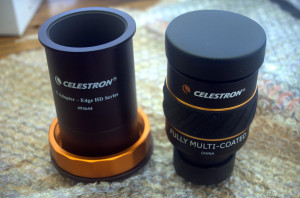It weren’t like that when I were a lad…but supposedly it makes things easier. These new auto-slewing mounts, with keypads programmed with a bazillion and one objects. All your deep sky objects, all your doubles, all your clusters, all your planets, all your everything, even no doubt things beyond the limit of the scope you are using.
No matter, I have one, and thought I’d try it. I can follow instructions, I am not a total technophobe, I always made sure the clock on my VCR was correct. And I know my way (ish) around the sky, this whole ‘two star alignment’, sure I can find the stars they want. So power it up and away we go. Well, not quite. First off, polar align it. Luckily, I know where Polaris is, and that is close enough to give me within a degree of the actual pole. I also know my latitude, again I can push the scope into position of that. Drag the mount down on to the patio, lined up, and let’s try and do the star alignment.
(Bear in mind this is the first time I did this, the second time went swimmingly. But I had read the instructions a bit closer before then. At this point, I had them in my hand, had read them and was now trying it.)
Turn on. Press a few ENTERs to get along a bit, ok. Right. Time. Check. Date. Check…wait, it said it was going to ask me my lat/long, or I could select my city. Nope. Ah well, battle on, it must know best. Right so. Choose a star to slew the scope to. Wait…I don’t recognise that one…hmm..southern hemisphere? That is a bit odd. Scroll throw..dammit, the direction buttons aren’t the scroll-through-menu buttons, the scope now moved, try again. Nope, not recognising any of these stars. Why is it offering me bits in the southern hemisphere? Eh? Read more. Dammit, where are those menu options. This makes NO SENSE. Read again. LESS SENSE.
(A slight break: the only intuitive interface is the nipple, everything else is learned. Anyone who says their interface is intuitive is lying. What they mean is they have gotten used to it by experience, and can’t remember what it was like to stumble through. Back to the post…)
One more read. More presses and clicks. Nothing. Nothing at all. So I gave up, did everything manually again.
The next (clear) night, I decided to try again. I read a few words I missed last time. When setting up, sure why not click back a few times at a certain point, *then* you can enter you lat/long, as that makes sense, that is a good way to get to it. Anyhow. Hoo-rah. Job done. Now go for the star alignment, hoping for the best…yup, stars I recognise, and can slew to. Excellent.
Of course, I still never really made much use of it (there is a star tour mode, the Messier/NGC/more catalogues) as I was tootling around in Gemini. But still, seems like it might be useful, if even just to save me from pushing the scope around when I want to hunt elsewhere.
But damn it isn’t a good interface. I still keep pushing the slew arrow the odd time in menu selections. Granted, the menu scroll selection buttons feel a bit different, I get I just have to get used to it. Then it will be intuitive.
Or I am just getting old, out of touch and tech is leaving me behind.

